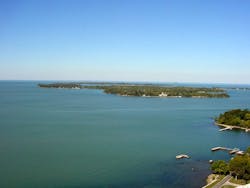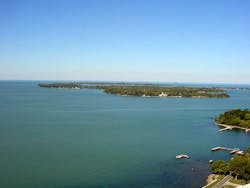EPA announces action plan to combat harmful algal blooms in Lake Erie
Lake Erie Islands. Credit: Wikimedia Commons.
CHICAGO MARCH 9, 2018 -- the U.S. Environmental Protection Agency announced the release of the United States’ domestic action plan for reducing phosphorus, a major contributor to harmful algal blooms, in Lake Erie. The plan outlines federal and state efforts to achieve the binational phosphorus reduction targets adopted by the United States and Canada in 2016 under the Great Lakes Water Quality Agreement.
"Today’s action plan is a significant step in fulfilling our commitment to protecting the health of Lake Erie,” said Great Lakes National Program Manager and Region 5 Administrator Cathy Stepp. “EPA is working with federal and state partners to ensure local communities and economies continue to benefit from this vital resource.”
The United States committed to reduce phosphorus nutrient sources by 40 percent, a reduction of 7.3 million pounds. Today’s action plan summarizes the actions federal agencies and states are taking across the Lake Erie basin and provides a mechanism for tracking progress.
While the bulk of the phosphorus reductions will come from sources in Ohio, Indiana and Michigan, all five states in the basin are committed to taking action to reduce nutrient loadings and minimize problems of excessive algal growth. The U.S. plan presents a coordinated approach to link and expand the efforts across the states to achieve the nutrient goals in the basin. Additionally, the states of Michigan, Ohio, Indiana and Pennsylvania each submitted individual action plans that describe specific phosphorus reduction measures in more detail.
Excessive algal growth poses substantial threats to both Lake Erie’s ecosystem and human health. More than 10 million people rely on the lake for clean drinking water, swimming and fishing opportunities. In the last decade, harmful and nuisance algal growth in the lake has increased significantly due to storms that deliver high levels of nutrients from major rivers. Recurring algal blooms and associated “dead zones” (oxygen-depleted areas created when algae die and decompose) threaten drinking water quality and Lake Erie’s critical $12.9 billion tourism industry and world class fishery.
EPA engaged stakeholders in the development of the domestic action plan in August and September 2017 through in-person engagement sessions with targeted stakeholder groups. The U.S. Action Plan can be accessed here: www.epa.gov/glwqa/

